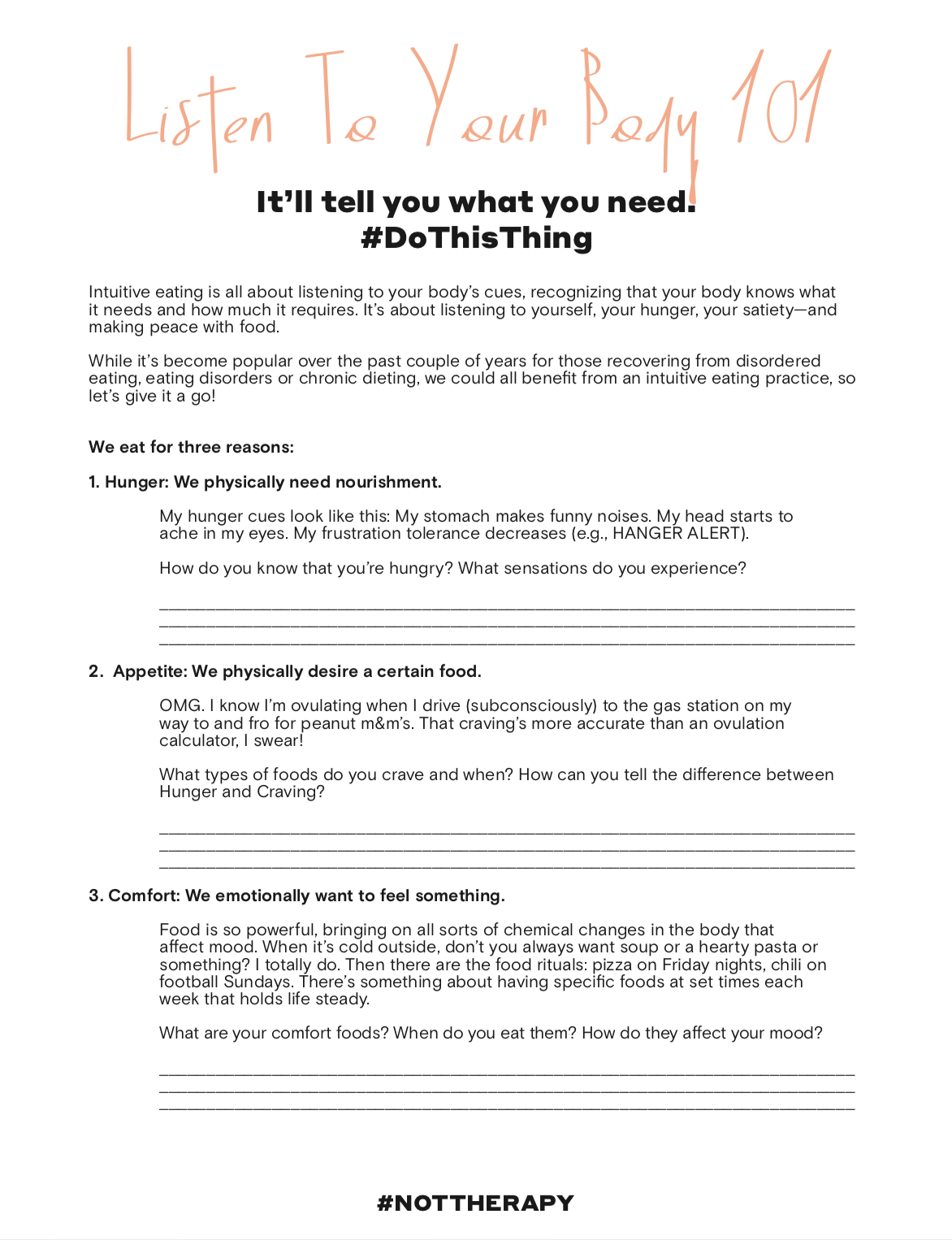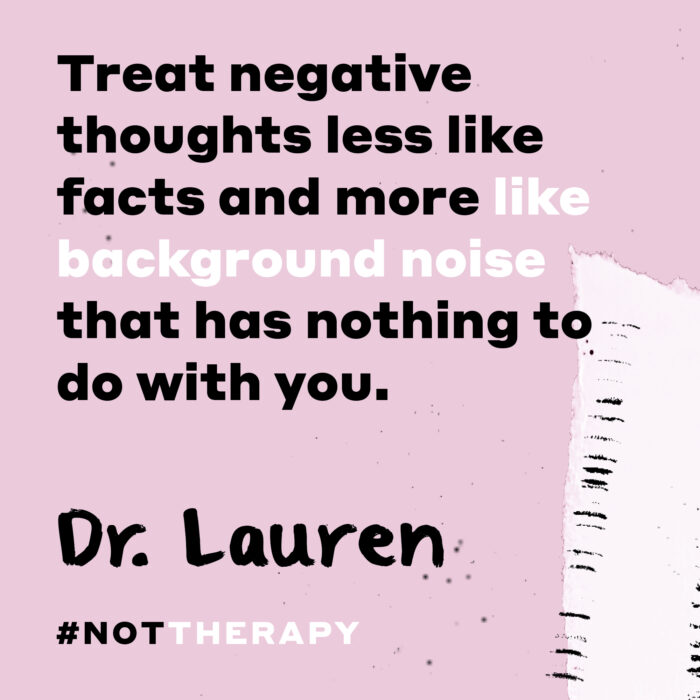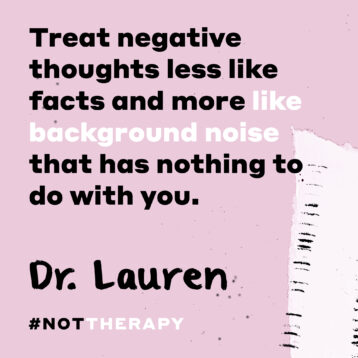Tell me if any of this sounds familiar.
Your thoughts. (My responses.)
OMG, I’m too fat. (Too fat for what?)
I’d be much happier, if I was skinnier. (Happier? Hungrier, maybe?)
I hate my *insert body part.* (Only because you bought society’s BS.)
I’ll never have a good body. (Who defines “good”?)
She has a perfect body. (Perfect to whom? Your body works, dear.)
I’ll never look like her. (And she will never look like you.)
Do I look as fat as I feel? (Do you feel well? Fat is not a feeling.)
I hate myself. (That’s a damn shame, cause I think you’re the coolest.)
I remember those days, the ones ruined by the negative voice screaming in my head about how fat I was and how weird I looked. We all hate on our bodies at some point in our lives.
My negative body image was pretty extreme and lasted from sixth grade until I got pregnant at age 27. Pregnancy allowed me to stop objectifying myself. I was finally able to see my body as the amazing machine that it is, rather than a conduit to acceptance.
For me, hating my body made me hate myself. For girls of all backgrounds, body dissatisfaction is a part of growing up in this society. You’d have to be a recluse, living off the land, on some mountain in the middle of nowhere not to be affected by society’s thin ideal.
It’s important to note, however, that body image concerns and eating disorders are not one in the same.
In honor of eating disorders awareness month, let’s address some of the common myths about ED. With more knowledge, we can increase our own awareness and be more supportive of friends who are struggling with body image concerns, disordered eating and eating disorders, too.
MYTH #1 Every girl has some sort of eating disorder.
No. They. Don’t. While disordered eating is super-common and many of us experience body dissatisfaction and engage in unhealthy eating behaviors, food rules and compensatory behaviors, not everyone has a diagnosable eating disorder. The key is to catch the problem before it becomes a full-blown issue like anorexia nervosa or bulimia nervosa, because eating disorder treatments work best when those who are suffering jump into solutions early in the illness.
MYTH #2 Eating disorders are a choice.
Total bullshit. Eating disorders are not a choice. They’re complex illnesses with biological and psychological components. The research on eating disorders points to genetic influences. Like everything else, ED are in the genes. Much like genetics influence diabetes and depression, genes also influence ED diagnoses. Of course, environmental stuff like the thin body ideal and social messaging serve as triggers for the illness—but they don’t cause the illness.
MYTH #3 Eating disorders are about wanting to be thin.
While ED often start with someone wanting to lose a few pounds, eating disorders take on a life of their own and the sufferer has little control. They often want to eat and can’t. The fear of gaining weight is paralyzing and the emotional distress is overwhelming. Suicide is common in those diagnosed with ED. Other consequences of ED are heart attack, kidney failure, osteoporosis and electrolyte imbalance. Bottom line: eating disorders are serious. They’re not about being skinny.
MYTH #4 Eating disorders are about an unhealthy relationship with food.
Our relationship with food is hard to separate from our connections with our caregivers from infancy—since those caregivers were our first source of every kind of sustenance. Basically, ED are NOT about our relationship to chocolate chip cookies or steamed broccoli, but ED can be related to our connections in infancy and our abilities to self-soothe and self-regulate.
MYTH #5 Only teen girls have eating disorders.
While ED are more common in girls, approximately one in four people diagnosed with ED are boys and men. And although most people who suffer are girls between the ages of 12 and 25, there is often a long time between when someone starts engaging in the behaviors and when they are diagnosed with an ED. Women of all ages are at risk. No group is immune.
MYTH #6 Eating disorders are extreme dieting.
While they are NOT one in the same, dieters are 5x more likely to develop eating disorders and extreme dieters are 18x more likely to develop eating disorders. IMO, it’s best to forget about “diets” and focus on a healthy lifestyle: one that includes a good night’s sleep, healthy amounts of exercise to increase the brain chemicals that make us feel good, and plenty of nutrients to fuel our brains and bodies.
MYTH #7 Eating disorders are a form of attention-seeking.
Actually, those who suffer from ED often go to extremes to hide their destructive behaviors and weight loss or gain. They are so good at keeping it to themselves that their family members often don’t intervene and assist them in receiving the care they need until the illness is quite advanced.
MYTH #8 Moms cause eating disorders.
Not true! Moms don’t cause ED, but their attitudes toward their own bodies and their relationship with food does impact their children’s views of themselves. Parents are models for kids, but ED have multiple influences and causes.
MYTH #9 Society alone causes eating disorders.
Yes, 80% of 10-year-olds have a serious fear of being overweight because our society makes it hard to see our value as being separate from our weight and shape. Being deluged with photoshopped images of bikini-clad beauties in one exotic locale after another certainly contributes to an unhealthy obsession with food and weight, but whether or not someone develops an eating disorder has a lot to do with other factors, too.
MYTH #10 Eating disorders will work themselves out as you get older and have more life experiences.
The hell they will! Eating disorders progressively get worse, not better. Those who suffer with ED require support to implement solutions. Motivation and readiness are helpful at the start of treatment but aren’t sufficient for recovery.
If you or a friend is struggling with an eating disorder, GO TO THERAPY. And while you wait, or if you’re just generally hating on your body, #DoThisThing.
Art by Janine Kuehn.









